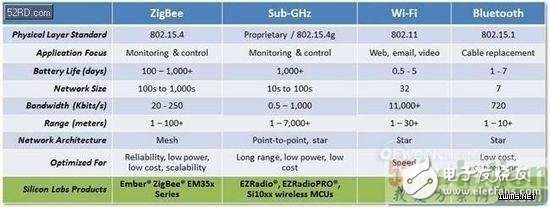It is estimated that around 50 billion wireless-enabled devices will be in use by 2020. According to the GSM Alliance, only a quarter of these are mobile handhelds or personal computers, while the remaining devices are autonomous systems that communicate with other machines without user interaction. Our Internet is rapidly evolving into the Internet of Things (IoT), specifically tailored for wireless devices.
**Core Features and Capabilities of Wireless Network Technology**
Wi-Fi operates on the 2.4 GHz band and excels at quickly transferring large data sets between two nodes. However, it consumes significant power and typically supports a limited number of clients per access point—usually up to 15–32.
Bluetooth is another 2.4 GHz technology designed for portable devices, primarily as a point-to-point solution that supports only a small number of connected nodes.
ZigBee shares the same frequency spectrum but is optimized for low-power, wireless sensor networks. It’s ideal for applications where energy efficiency and long battery life are critical.

*Table 1 summarizes the core features and capabilities of current wireless network technologies.*
**ZigBee: Optimized Solution for Wireless Mesh Networks**
ZigBee is an open, standards-based mesh networking technology that allows for self-configuring and self-healing networks. Unlike traditional topologies like star or peer-to-peer, ZigBee uses a dynamic routing protocol based on AODV (Ad Hoc On-Demand Distance Vector). When a node needs to connect, it broadcasts a route request, and neighboring nodes check their routing tables. If a path exists, they respond, allowing the source node to select the most reliable and shortest path. If a route fails, alternative paths are automatically found, ensuring continuous connectivity even in challenging environments.
**Network Topology Comparison**
ZigBee-based wireless sensor networks, such as those built using Silicon Labs' EM35x Ember ZigBee SoC and EmberZNet PRO stacks, can support hundreds or even thousands of nodes in a single network. The development of "ZigBee Certified Products" has been greatly aided by tools like Ember AppBuilder, which simplifies the process by hiding complex protocol details and focusing on application-specific features through ZAP (ZigBee Application Profiles).
For efficient debugging, specialized tools like the Silicon Labs Desktop Network Analyzer are essential. Traditional packet sniffers often struggle with mesh networks due to the multi-hop nature of transmissions. This tool provides a visual interface that tracks packets across the entire network, helping developers understand and optimize communication performance.
In some cases, mesh networks may not be the best choice. For example, in environments with sparse node deployment—like roads, railways, or remote campus areas—a star topology may offer better reliability and longer coverage.
**Sub-GHz: Ideal for Long Distance and Low Power Communication**
Sub-GHz radio frequencies offer advantages in terms of power efficiency, long-range communication, and signal penetration through walls. Frequencies like 433 MHz are widely used globally (except in Japan), while 868 MHz and 915 MHz are popular in Europe and the U.S., respectively.
Sub-GHz bands experience less interference compared to the crowded 2.4 GHz spectrum, leading to more stable and efficient communication. This reduces retransmissions and improves overall network performance.
Many sub-GHz transceivers, such as the Silicon Labs Si446x EZRadioPRO IC, support a wide frequency range (119 MHz to 1050 MHz) and offer ultra-low power consumption, with just 50nA in sleep mode. They also include features like dual antenna support and antenna diversity to combat signal fading. With techniques like frequency hopping and clock synchronization, sub-GHz networks can span several kilometers, making them ideal for large-scale IoT deployments where power sources are limited.
For Oil Immersed Power Transformer, we can produce voltage from 35kV to 500kV, capacity upto 460MVA. We use the best quality of raw material and advance design software to provide low noise, low losses, low partial discharge and high short-circuit impedance for power transformer.
Our power transformer are widely used in national grid, city grid, rural grid, power plant, industrial and mining enterprise, and petrochemical industry.
Cast Resin Transformer,Power Transformer,Renewable Transformer,Power Transformer With Oltc
Hangzhou Qiantang River Electric Group Co., Ltd.(QRE) , https://www.qretransformer.com
